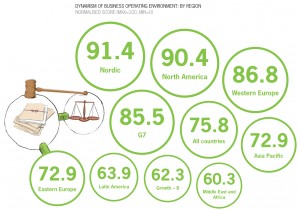-
Auditoría Interna
Servicios de Auditoría Interna. Nuestra firma, se especializa en servicios de auditoría interna utilizando metodologías bajo estándares internacionales.
-
Revisoría fiscal
Los servicios de Revisoría Fiscal de la Firma han sido diseñados para apoyarle a cumplir con los desafíos que implica el administrar riesgos, recursos e información.
-
Auditoría externa
Firma líder de Auditoría externa en Colombia, nuestro servicio tiene como objetivo expresar una opinión independiente en relación con la razonabilidad de los Estados Financieros de las empresas o ciertas áreas de negocios en cuyo caso utilizamos procedimientos previamente convenidos
-
Auditoría externa de gestión y resultados
Nuestro trabajo cosiste en la ejecución de procedimientos definidos para la revisión de la información contable y la emisión de los informes y documentos correspondientes.
-
Impuestos
Acompañamiento a nuestros clientes en todas las etapas necesarias para lograr un cierre fiscal exitoso, buscando optimizar el pago de los impuestos y aliviar la carga tributaria.
-
Precios de Transferencia y Atribución de Rentas
En Grant Thornton estamos preparados para que nuestros clientes encuentren asesoría completa, identificando la naturaleza de sus operaciones con vinculados en el exterior, con el fin de cumplir con los requisitos exigidos por la administración tributaria.
-
Servicios Legales
Firma líder en Servicios Legales en Colombia, contamos con expertos calificados y oficinas en las principales ciudades del país.
-
Diagnóstico e implementación de NIIF plenas y NIIF para las PYMES
Servicios de Diagnóstico e implementación de NIIF plenas y NIIF para las PYMES
-
Capacitación y actualización en NIIF
Servicios de Capacitación y actualización en NIIF
-
Cálculo de estimaciones contables bajo NIIF
Servicios de Cálculo de estimaciones contables bajo NIIF
-
Valoración de instrumentos financieros
Servicios de Valoración de instrumentos financieros
-
Asesoría en consultas especializadas
Servicios de Asesoría en consultas especializadas
-
Asesoría en NIIF para entidades del sector público
Servicios de Asesoría en NIIF para entidades del sector público
-
Preparación de estados financieros y revelaciones
Servicios de Preparación de estados financieros y revelaciones
-
Contabilidad financiera
Nuestro apoyo involucra el diseño de la organización contable con el fin de ajustar el mantenimiento de registros y presentación de informes a sus necesidades.
-
Servicios tributarios
Firma líder en servicios de Cumplimiento tributario y legal con expertos calificados y presencia en las principales ciudades de Colombia.
-
Nómina
Firma líder en servicios de Nómina con expertos calificados y presencia en las principales ciudades de Colombia.
-
Auditoría de servicios de Sarbanes-Oxley
Aplica tanto para la implementación de servicios relacionados con la estructuración del modelo de control derivado de la ley SOX como con la auditoría independiente para certificar su cumplimiento.
-
Auditoría de controles de la organización
Con el fin de ayudar a la organización de servicio y sus usuarios a establecer un proceso confiable y estándar para los reportes de la organización de servicio, ofrecemos los siguientes servicios:
-
Auditoria de TI
Los servicios de auditoría de TI ayudan a la Organización a gestionar los riesgos y controles relacionados con la implementación y el uso de TI para el logro de los objetivos financieros, operativos y regulatorios del negocio.
-
Seguridad informática
La ciberseguridad enmarca un conjunto de herramientas, políticas, salvaguardas de seguridad, directrices, métodos de gestión de riesgos, acciones, formación y en resumen una serie de prácticas que pueden utilizarse para proteger los activos de la organización y los usuarios en el ciberentorno.
-
Pruebas de rendimiento
Nuestro servicio se enfoca en determinar la rapidez en la cual se realiza una tarea en condiciones particulares de trabajo sobre un sistema de información o aplicación específico.
-
Auditoria seguridad social
Como parte de las políticas y estrategias de la seguridad Social en Colombia, la pensión y la salud son derechos fundamentales de los trabajadores, para lo cual se requiere apoyo especializado para garantizar el acceso a estos derechos, de manera transparente, equitativa y con apego a la ley.
-
Servicios BCP
Estamos certificados por el DRI Internacional como Consultor en Planes de Continuidad del Negocio, CBCP y con entrenamiento y certificación como auditor interno en SGS, norma ISO 2005:27001.
-
Auditoría y seguridad informática SAP
Contamos con expertos certificados en seguridad y auditoría SAP en R/3, CRM, BW. Nuestro enfoque nos permite realizar en SAP Auditoría y Seguridad informática, ingresa ahora para conocer en detalle nuestro servicio.

-
Gestión de riesgo corporativo
Este entorno regulatorio, busca atenuar los riesgos y las incertidumbres de la industria bancaria, respondiendo también a las presiones económicas, y a las expectativas de los inversionistas.
-
Mejora operacional
La gestión por procesos, dentro de la cual se enmarca la mejora operacional, puede definirse como una forma de enfocar el trabajo, donde se busca el mejoramiento continuo de las actividades de una organización mediante la identificación, selección, descripción, documentación y mejora continua de los procesos.
-
Gestión del cambio
La gestión del cambio es el proceso, que a través de herramientas y técnicas, permite gestionar la transición hacia una nueva realidad, intentando que las personas involucradas sean capaces y deseen trabajar en el nuevo contexto definido y se consigan los resultados esperados.
-
Inteligencia y análisis de negocios
La inteligencia de negocio actúa como un factor estratégico para una organización, generando una potencial ventaja competitiva, que no es otra que proporcionar información privilegiada para responder a los problemas de negocio.

-
Due Diligence
La diligencia debida o Due Diligence es un término, utilizado habitualmente en el ámbito de las adquisiciones empresariales, para referirse al proceso de búsqueda de información sobre una organización.
-
Valoraciones
La valoración de una empresa no es una ciencia exacta y puede variar en función del tipo de negocio y el motivo.
The risk-reward trade-off of investing in the Growth-8 economies
One of the most interesting aspects of our recent Global Dynamism Index (GDI) was the strong performance of mature economies. It was a result Ed Nusbaum described as counterintuitive in that the word dynamism tends to be attributed to faster growing emerging markets such as the BRIC economies.
The father of the ‘BRIC’ acronym, Jim O’Neill of Goldman Sachs, now highlights the ‘Growth-8’ economies – Brazil, China, India, Indonesia, Korea, Mexico, Russia and Turkey – as being the key drivers of global growth over the next few years.
Their forecast growth rates are certainly impressive. In the period 2012-17, the IMF expects them to account for 47% of global growth, catapulting all eight into the world’s largest twenty economies.[1]
But do these rapidly expanding economies offer the best growth environments for dynamic businesses?
According to the GDI, the answer is no. The Growth-8 economies scored 55.0[2] for the overall dynamism of their economies, below the global average (57.3) and well behind the G7 (59.6). The Growth-8 come out on top in terms of the dynamism of their economics & growth, but they come third bottom in science & technology, second bottom in business operating environment, and bottom overall in financing environment.
Individually, Korea – the most advanced of the eight – ranks in the top ten and China sits in 20th place, but the remaining six rank in the bottom half of the 50 economy index. India, Indonesia and Russia sit in the bottom ten.
Of course the GDI is far more than simply another measure of growth. By considering key drivers of business location decisions such as political stability, IT infrastructure and access to finance, the index gives a much more rounded picture of the potential challenges of operating in different markets.
The key question for business leaders considering investing in the Growth-8 economies is whether the potential rewards outweigh the risks.
[1] IMF 2012
[2] Modelling the indicators and categories results in scores of 0-100 for each country, where 100 represents the most dynamic environment and 0 the least.


